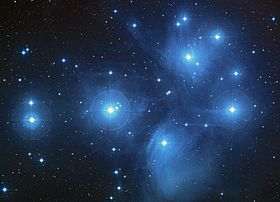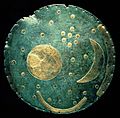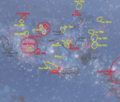Pleiades facts for kids
Quick facts for kids Pleiades |
|
|---|---|

|
|
| Observation data (J2000 epoch) | |
| Constellation | Taurus |
| Right ascension | 03h 47m 24s |
| Declination | +24° 07′ 00″ |
| Distance | 444 ly on average (136.2±1.2 pc) |
| Apparent magnitude (V) | 1.6 |
| Apparent dimensions (V) | 110' (arcmin) |
| Physical characteristics | |
| Other designations | M45, Seven Sisters, Melotte 22 |
The Pleiades (also called M45 or the Seven Sisters) is a famous group of stars in the night sky. You can easily spot them in the constellation Taurus, which looks like a bull. A French astronomer named Charles Messier gave it the name M45. The cluster is named after the Pleiades from ancient Greek mythology.
This group of stars is an open cluster. It is made of hot, middle-aged stars called B-type stars. The Pleiades is one of the closest star clusters to Earth. It is also the easiest cluster to see without a telescope, just using your naked eye. The cluster shines brightly with hot, blue stars. These stars are quite young, having formed in the last 100 million years.
Images for kids
-
The Nebra sky disk, made around 1600 BC. The dots in the upper right are thought to be the Pleiades.
-
An image from the Hubble Space Telescope showing a cloud of gas and dust near the star Merope (IC 349).
-
The Pleiades are located just above the Local Bubble in the middle of this map of the Orion Arm. Yellow shows major star groups, red shows bright clouds, and grey shows dark clouds.
See also
 In Spanish: Pléyades (astronomía) para niños
In Spanish: Pléyades (astronomía) para niños









